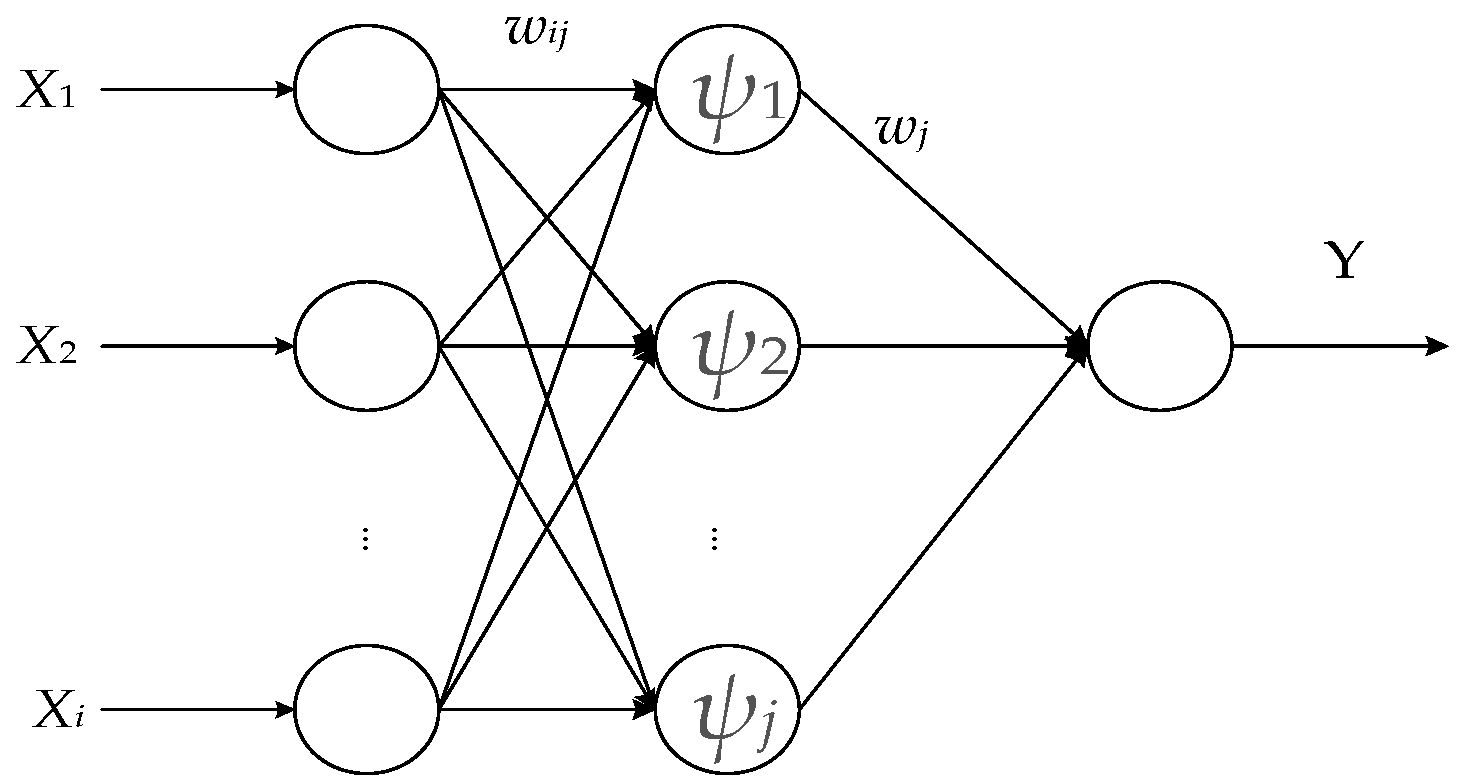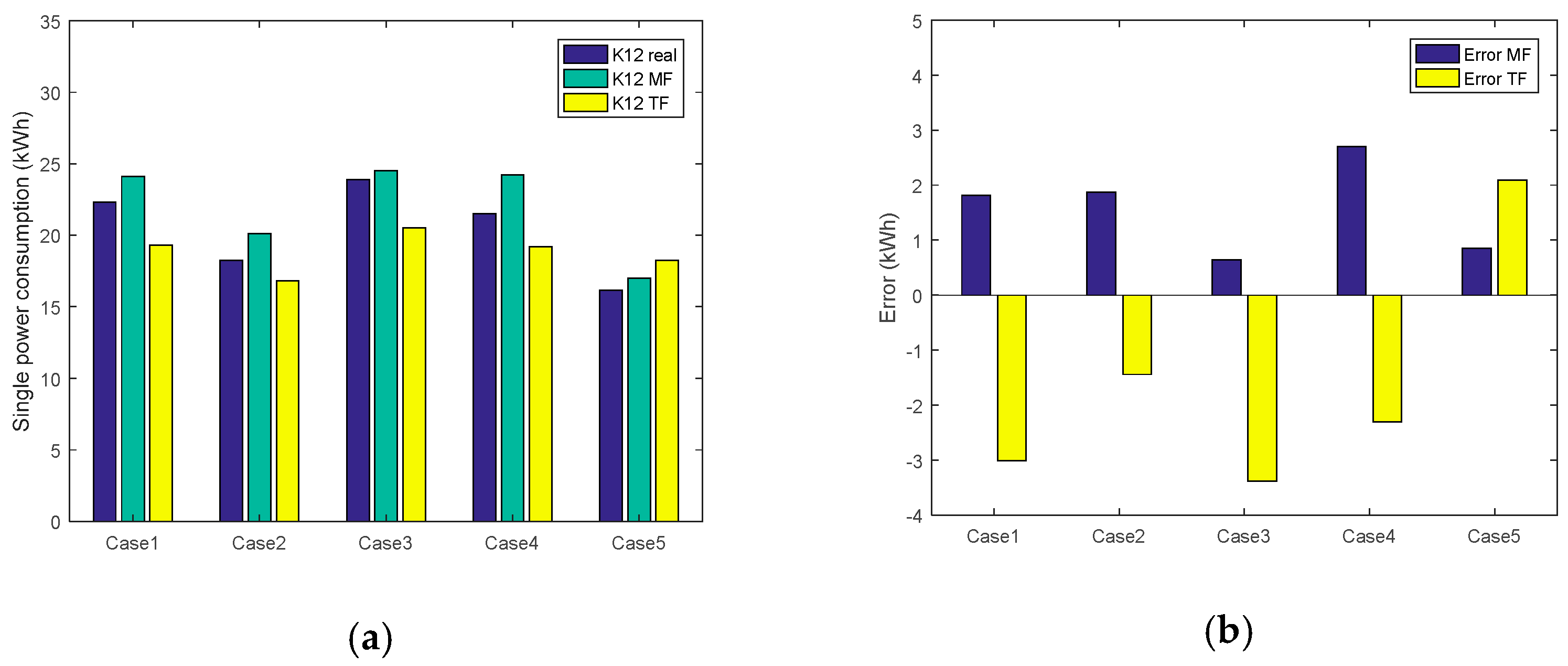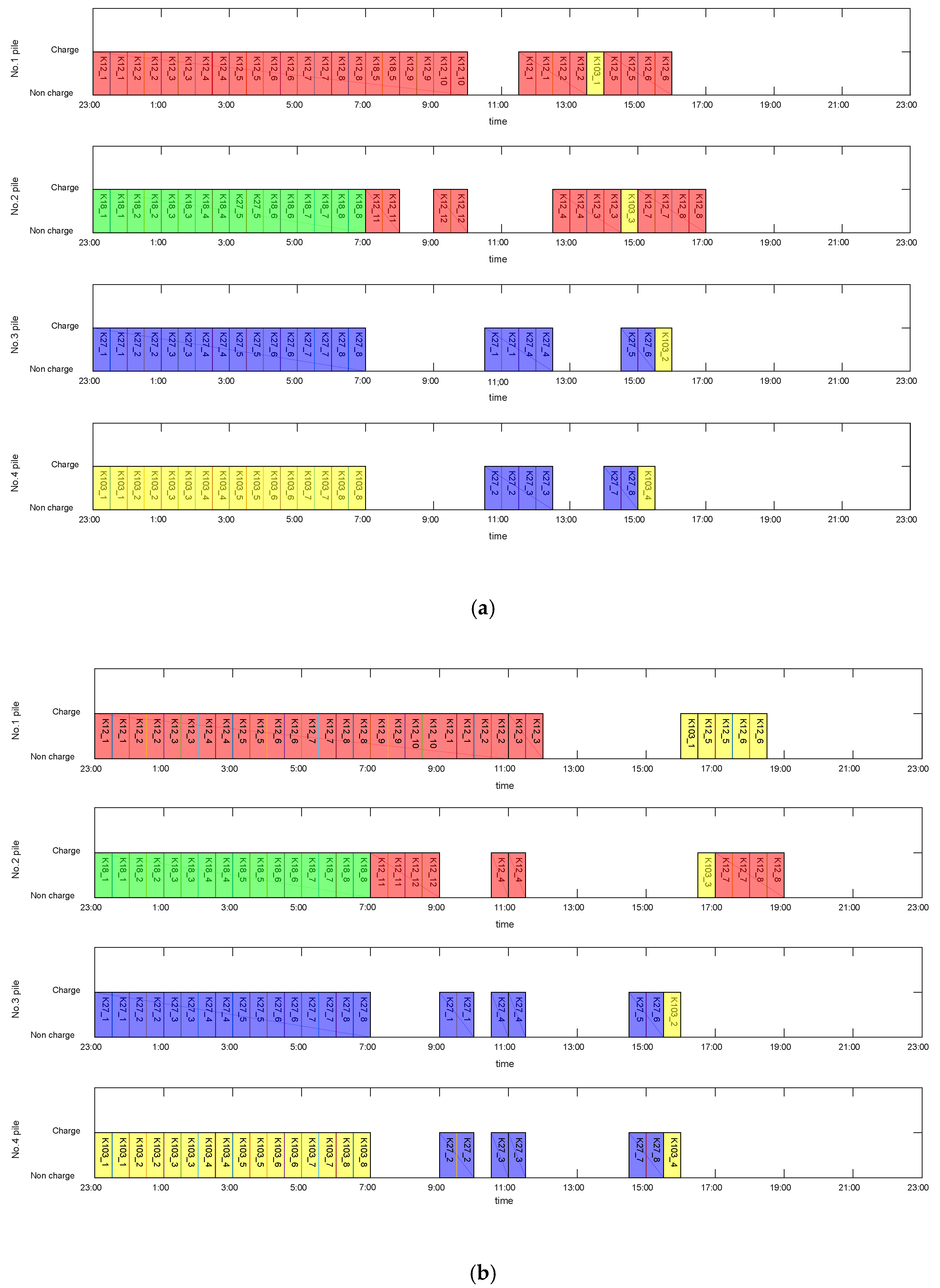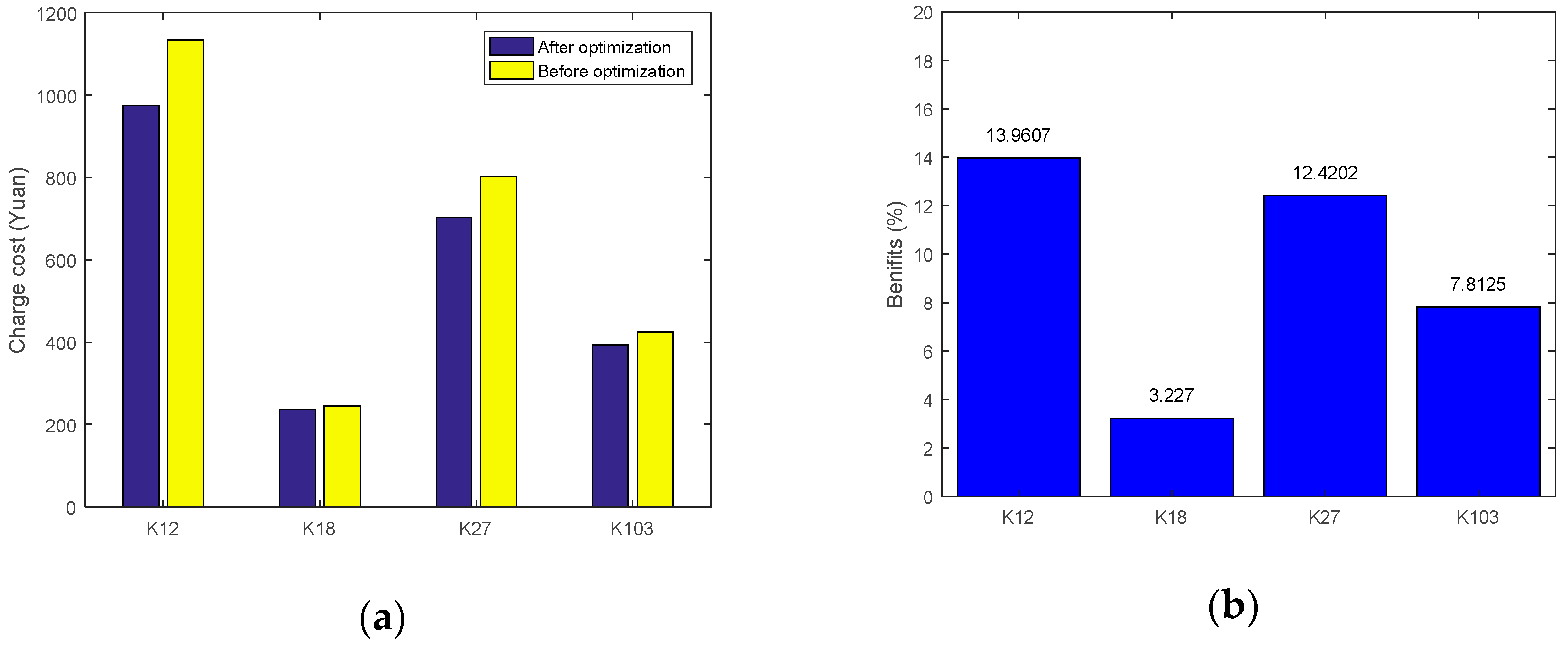An Electric Bus Power Consumption Model and Optimization of Charging Scheduling Concerning Multi-External Factors
Abstract
:1. Introduction
2. Selection of Similar Days Considering Fuzzy Evaluation and Analysis of Influencing Factors
2.1. Fuzzy Evaluation of the Feature Library of Influence Factors
2.1.1. Establishment of Power Consumption Feature Library
2.1.2. Fuzzy Quantification of Influencing Factors
2.2. Selection of Similar Days Based on Improved Grey Relational Analysis (GRA)
3. Adaptive Wavelet Neural Network (WNN) Power Consumption Prediction Model Considering Multiple Factors
3.1. An Overview of WNN
3.2. Training and Learning of WNN
3.3. The Prediction Process of WNN
4. Establishment of Charging Optimization Model for Electric Buses
4.1. Optimization Research Model of EBs
4.2. Optimization Goal
4.3. Constraint Condition
4.4. Solution of Optimal Model
5. Case Study
5.1. Power Consumption Model of Bus Based on the Adaptive WNN
5.2. Charging Optimization for EB with Different Charging Piles
5.3. Analysis on the Cost of Optimized Charging
5.4. Summary for the Case Analysis
6. Conclusions
Author Contributions
Acknowledgments
Conflicts of Interest
Abbreviations
| EBs | electric buses |
| GRA | The grey relational analysis |
| SOC | Stage of charge |
| WNN | the wavelet neural network |
| ELM | extreme learning machine |
| GA | genetic algorithm |
| TOU | time of use |
| MF | Multi factors forecast |
| TF | Traditional forecast |
References
- Zhang, P.; Yan, F.; Du, C. A comprehensive analysis of energy management strategies for hybrid electric vehicles based on bibliometrics. Renew. Sustain. Energy Rev. 2015, 48, 88–104. [Google Scholar] [CrossRef]
- A Review of the Development of New Energy Automobile Industry in the Transportation Industry in the Period of “12th Five-Year”. Available online: http://gjss.ndrc.gov.cn/zttp/xyqzlxxhg/201712/t20171221_871251.html (accessed on 21 December 2017).
- Speeding up the Application of New Energy Vehicles in the Transportation Industry. Available online: http://www.mot.gov.cn/jiaotongyaowen/201510/t20151014_1897377.html (accessed on 26 March 2015).
- Dominković, D.F.; Bačeković, I.; Pedersen, A.S.; Krajačić, G. The future of transportation in sustainable energy systems: Opportunities and barriers in a clean energy transition. Renew. Sustain. Energy Rev. 2017, 82, 1823–1838. [Google Scholar] [CrossRef]
- Zhang, T.; Chen, X.; Yu, Z.; Zhu, X.; Shi, D. A Monte-Carlo Simulation Approach to Evaluate Service Capacities of EV Charging and Battery Swapping Stations. IEEE Trans. Ind. Inf. 2018. [CrossRef]
- Lajunen, A.; Lipman, T. Lifecycle cost assessment and carbon dioxide emissions of diesel, natural gas, hybrid electric, fuel cell hybrid and electric transit buses. Energy 2016, 106, 329–342. [Google Scholar] [CrossRef]
- Zhang, X.; Qiushuo, L.I.; Tao, S.; Xiao, X.; Zhao, B. Influence Factors Analysis and Modeling of Power Demand for Electric Bus Charging Station. Mod. Electr. Power 2014, 31, 28–33. [Google Scholar] [CrossRef]
- Wang, M.Y.; Zhang, H.X.; Zhang, T.Z.; Liu, Y. Study on Response Surface Model of Actual Power Consumption of Electric Buses. J. Qingdao Univ. 2014, 29, 49–53. [Google Scholar]
- The Average PM2.5 Concentration Dropped 9.9% Last Year. Available online: http://bjrb.bjd.com.cn/html/2017-01/04/content_94194.htm (accessed on 4 January 2017).
- Bento, P.M.R.; Pombo, J.A.N.; Calado, M.R.A.; Mariano, S. A bat optimized neural network and wavelet transform approach for short-term price forecasting. Appl. Energy 2018, 210, 88–97. [Google Scholar] [CrossRef]
- Sun, W.; Zhang, C. A Hybrid BA-ELM Model Based on Factor Analysis and Similar-Day Approach for Short-Term Load Forecasting. Energies 2018, 11, 1282. [Google Scholar] [CrossRef]
- Dai, S.; Niu, D.; Li, Y. Daily Peak Load Forecasting Based on Complete Ensemble Empirical Mode Decomposition with Adaptive Noise and Support Vector Machine Optimized by Modified Grey Wolf Optimization Algorithm. Energies 2018, 11, 163. [Google Scholar] [CrossRef]
- Stroe, A.I.; Meng, J.; Stroe, D.I.; Świerczyński, M.; Teodorescu, R.; Kær, S.K. Influence of Battery Parametric Uncertainties on the State-of-Charge Estimation of Lithium Titanate Oxide-Based Batteries. Energies 2018, 11, 795. [Google Scholar] [CrossRef]
- Teshigawara, Y.; Ikegami, T. Charging Load Aggregation Potential of Multiple Electric Vehicles Based on Road Traffic Census Data. Electr. Eng. J. 2018, 203, 64–371. [Google Scholar] [CrossRef]
- Mumtaz, S.; Ali, S.; Ahmad, S.; Khan, L.; Hassan, S.Z.; Kamal, T. Energy Management and Control of Plug-In Hybrid Electric Vehicle Charging Stations in a Grid-Connected Hybrid Power System. Energies 2017, 10, 1923. [Google Scholar] [CrossRef]
- Bao, Y.; Luo, Y.; Zhang, W.; Huang, M.; Wang, L.Y.; Jiang, J. A Bi-Level Optimization Approach to Charging Load Regulation of Electric Vehicle Fast Charging Stations Based on a Battery Energy Storage System. Energies 2018, 11, 229. [Google Scholar] [CrossRef]
- Caramanis, M.; Foster, J.M. Management of electric vehicle charging to mitigate renewable generation intermittency and distribution network congestion. In Proceedings of the Joint 48th IEEE Conference on Decision and Control and 28th Chinese Control Conference, Shanghai, China, 16–18 December 2009; pp. 4717–4722. [Google Scholar]
- Bagher Sadati, S.M.; Moshtagh, J.; Shafie-khah, M.; Catalão, J.P.S. Risk-Based Bi-Level Model for Simultaneous Profit Maximization of a Smart Distribution Company and Electric Vehicle Parking Lot Owner. Energies 2017, 10, 1714. [Google Scholar] [CrossRef]
- Kong, F.; Jiang, J.; Ding, Z.; Hu, J.; Guo, W.; Wang, L. A Personalized Rolling Optimal Charging Schedule for Plug-In Hybrid Electric Vehicle Based on Statistical Energy Demand Analysis and Heuristic Algorithm. Energies 2017, 10, 1333. [Google Scholar] [CrossRef]
- Li, L.; Yan, B.; Yang, C.; Zhang, Y.; Chen, Z.; Jiang, G. Application oriented stochastic energy management for plug-in hybrid electric bus with AMT. IEEE Trans. Veh. Technol. 2016, 65, 4459–4470. [Google Scholar] [CrossRef]
- Azizivahed, A.; Naderi, E.; Narimani, H.; Fathi, M.; Narimani, M.R. A new bi-objective approach to energy management in distribution networks with energy storage systems. IEEE Trans. Sustain. Energy 2018, 9, 56–64. [Google Scholar] [CrossRef]
- Krasopoulos, C.T.; Beniakar, M.E.; Kladas, A.G. Multi-Criteria PM Motor Design based on ANFIS evaluation of EV Driving Cycle Efficiency. IEEE Trans. Transp. Electrif. 2018. [CrossRef]
- Khan, M.S.A.; Abdullah, S. Interval-valued Pythagorean fuzzy GRA method for multiple-attribute decision making with incomplete weight information. Int. J. Intell. Syst. 2018, 33, 1689–1716. [Google Scholar] [CrossRef]
- Santhosh, M.; Venkaiah, C.; Kumar, D.M.V. Ensemble empirical mode decomposition based adaptive wavelet neural network method for wind speed prediction. Energy Convers. Manag. 2018, 168, 482–493. [Google Scholar] [CrossRef]
- Si, J.; Wang, Y.T. Online learning control by association and reinforcement. IEEE Trans. Neural Netw. 2001, 12, 264–276. [Google Scholar] [CrossRef] [PubMed] [Green Version]
- Abdalrahman, A.; Zhuang, W. A Survey on PEV Charging Infrastructure: Impact Assessment and Planning. Energies 2017, 10, 1650. [Google Scholar] [CrossRef]
- Yang, Y.; Zechun, H.U.; Song, Y. Research on Optimal Operation of Battery Swapping and Charging Station for Electric Buses. Proceed. CSEE 2012, 32, 35–42. [Google Scholar]










| Characteristic Quantity | Fuzzy Quantization Rule |
|---|---|
| Day type (D) | Tue. to Fri. set to 1; Sat., Sun., Mon. set to 2 |
| Maximum temperature (TM) | <25 °C set to 1; 25~30 °C set to 2; >30 °C set to 3 |
| Minimum temperature (TN) | <10 °C set to 1; 10~20 °C set to 2; >20 °C set to 3 |
| Rainfall (R) | No rain set to 0; rain set to 2; heavy rain set to 3 |
| Length of travel path (S) | <10 km set to 1; 10~30 km set to 2; >30 km set to 3 |
| Haze index (PM2.5) | <50 set to 1; 50~150 set to 2; >150 set to 3 |
| Air-conditioned (A) | Open set to 1; while close set to 0 |
| Peak/non peak (P) | Peak set to 1; while none peak set to 0 |
| Limit/none-limited (L) | Limit set to 1; while none limit set to 0 |
| Diurnal eigenvectors (V) | V(D, TM, TN, R, S, PM2.5, A, P, L) |
| Case | Classification |
|---|---|
| Case 1 | Condition limit non peak |
| Case 2 | Condition non-limit peak |
| Case 3 | Condition peak limit |
| Case 4 | Condition limit non peak |
| Case 5 | Non-condition non-limited |
| Power Consumption per 100 km (kW∙h) | |||
|---|---|---|---|
| Case Classification | Predictive Value Concerning Multiple Factors | Real Value | Predictive Value of Fixed Energy Consumption |
| Condition limit non peak (Case 1) | 80.20 | 77.538 | 70.28 |
| Condition non-limit peak (Case 2) | 64.59 | 63.39 | 60.15 |
| Condition peak limit (Case 3) | 85.55 | 82.84 | 71.50 |
| Condition limit non peak (Case 4) | 76.02 | 74.7 | 68.53 |
| Non-condition non-limited (Case 5) | 57.18 | 56.11 | 58.21 |
| Rank Classification | Period | Price (Yuan) |
|---|---|---|
| Peak period | 10:00–14:00 18:00–20:00 | 1.164 |
| Flat period | 7:00–10:00 14:00–18:00 20:00–23:00 | 0.754 |
| Valley period | 23:00–next day 7:00 | 0.365 |
© 2018 by the authors. Licensee MDPI, Basel, Switzerland. This article is an open access article distributed under the terms and conditions of the Creative Commons Attribution (CC BY) license (http://creativecommons.org/licenses/by/4.0/).
Share and Cite
Gao, Y.; Guo, S.; Ren, J.; Zhao, Z.; Ehsan, A.; Zheng, Y. An Electric Bus Power Consumption Model and Optimization of Charging Scheduling Concerning Multi-External Factors. Energies 2018, 11, 2060. https://doi.org/10.3390/en11082060
Gao Y, Guo S, Ren J, Zhao Z, Ehsan A, Zheng Y. An Electric Bus Power Consumption Model and Optimization of Charging Scheduling Concerning Multi-External Factors. Energies. 2018; 11(8):2060. https://doi.org/10.3390/en11082060
Chicago/Turabian StyleGao, Yajing, Shixiao Guo, Jiafeng Ren, Zheng Zhao, Ali Ehsan, and Yanan Zheng. 2018. "An Electric Bus Power Consumption Model and Optimization of Charging Scheduling Concerning Multi-External Factors" Energies 11, no. 8: 2060. https://doi.org/10.3390/en11082060





